|
[#1]
Very beautiful. I hope to one day see these places.
Did you stop by the Chapel Quo Vadis? History of Quo Vadis Along the Via Appia Antica, famous for its Christian catacombs, is the legendary site where the soon-to-be-Saint Peter, scurrying away from the Christian persecutions in Rome, met a vision of Christ blocking the road. The church built beside that site is called Domine, Quo Vadis—an odd name for a church, until you hear the parable behind it. The vision of Christ replied, "To Rome, to be crucified a second time," whereupon Jesus disappeared, leaving his footprints in the road's flagstone as a sign (there's a cast of them inside the church). A chastened Peter realized that Christ meant he was going to take the place of the weak-willed first pope and die, once again, for his faith. Peter turned around and returned to Rome to take his martyrdom like a man. (In fact, when it came to the moment, Peter gritted his teeth and told his executioners he was unworthy of being crucified in the same manner as his Lord and, in effect, asked them to "Do me upside down." This is why there are still a few St. Peter-related holy sites around Rome sporting upside-down crosses—so no, they're not for Satan-worshippers.) - See more at: http://www.reidsitaly.com/destinations/lazio/rome/sights/quo_vadis.html#.dpuf ETA : whenever I read about St Peter it makes me happy. He shows us that we are all so flawed & yet we can still be forgiven by God & risen so high by Him. It gives me so much hope. |
|
|
|
[#3]
My parents took my wife and I to Rome last November. Spent 11 days over there, only two outside of Rome (Assisi, Florence).
I could go back and probably spend another week just at St Peter's. We got lucky once, and timed it properly another time, to attend Mass at St. Peter's. It was in the chapel at the back with the Chair of Peter behind the altar; I'm sure you got a picture of it. Wednesday audience, Angelus on Sunday, all of the other major churches around town...lots to do without even touching on the secular history of the city. |
|
|
|
[#4]
Quoted:
Very beautiful. I hope to one day see these places. Did you stop by the Chapel Quo Vadis? History of Quo Vadis Along the Via Appia Antica, famous for its Christian catacombs, is the legendary site where the soon-to-be-Saint Peter, scurrying away from the Christian persecutions in Rome, met a vision of Christ blocking the road. The church built beside that site is called Domine, Quo Vadis—an odd name for a church, until you hear the parable behind it. The vision of Christ replied, "To Rome, to be crucified a second time," whereupon Jesus disappeared, leaving his footprints in the road's flagstone as a sign (there's a cast of them inside the church). A chastened Peter realized that Christ meant he was going to take the place of the weak-willed first pope and die, once again, for his faith. Peter turned around and returned to Rome to take his martyrdom like a man. (In fact, when it came to the moment, Peter gritted his teeth and told his executioners he was unworthy of being crucified in the same manner as his Lord and, in effect, asked them to "Do me upside down." This is why there are still a few St. Peter-related holy sites around Rome sporting upside-down crosses—so no, they're not for Satan-worshippers.) - See more at: http://www.reidsitaly.com/destinations/lazio/rome/sights/quo_vadis.html#.dpuf ETA : whenever I read about St Peter it makes me happy. He shows us that we are all so flawed & yet we can still be forgiven by God & risen so high by Him. It gives me so much hope. View Quote Now I'm sorry we missed that. I knew the story, but didn't know about the church. |
|
|
|
[#6]
|
|
|
|
[#8]
Quoted:
My wife and I decided to climb the stairs. The monk in charge promptly kicked us out because my wife's dress was about an inch too short. Oh well, at least we made it up one step.  You could touch the actual stairs through holes in the wooden ones which was pretty cool. You could touch the actual stairs through holes in the wooden ones which was pretty cool.View Quote Pics of wife's skirt?  - Just kidding. - Just kidding.
Awesome pictures. I lived about 90 minutes south of Rome for two years and made a handful of trips there, including multiple visits to St. Peters. Also fortunate enough to get a visit to Bethlehem and Jerusalem while I was overseas. Amazing places that really connect you to the past. |
|
|
|
[#9]
As the end to our time in Rome was drawing near, it was time for the big one.
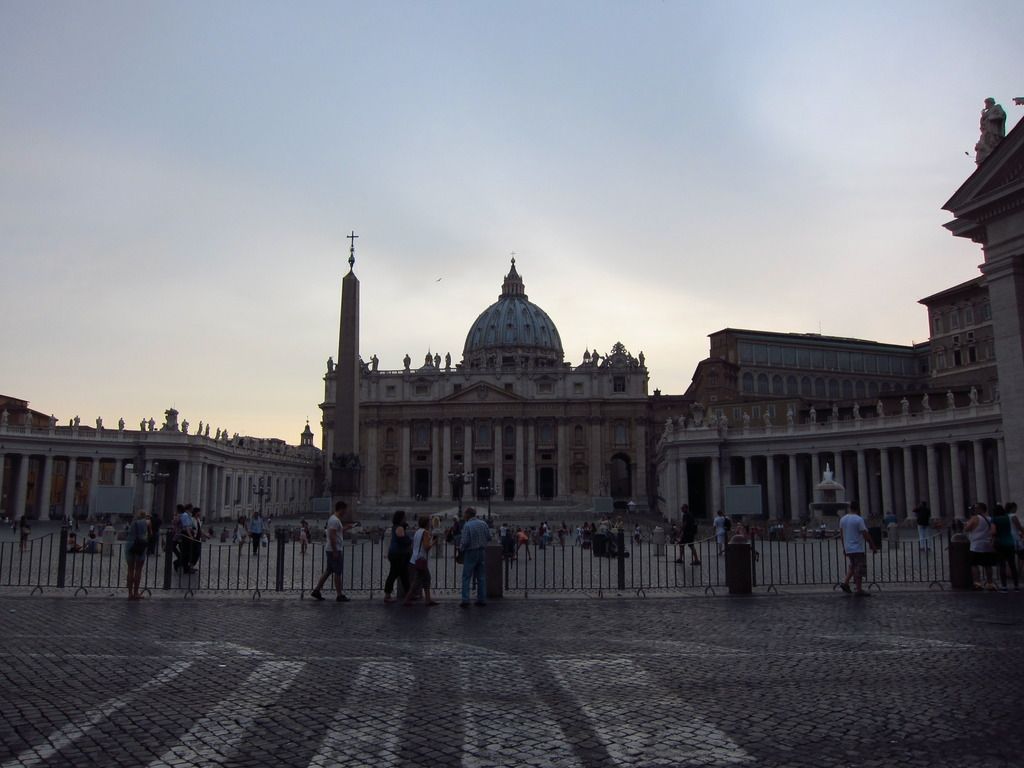
Several months before the trip, I booked tickets for the "Scavi tour" under St. Peter's. They only allow 100 or so people a day in to the excavations so booking well in advance is a must. Tradition has always held that the apostle Peter was buried under the altar of St. Peter's Basilica. During some renovations in the 1920s, they started finding cool stuff. The site of St. Peter's was originally a Roman Circus (chariot track) and a Necropolis (cemetery) sprouted up next to it. Tradition holds that St. Peter was executed in that Circus and then buried on the hill next door (the necropolis). They decided to carefully excavate everything that had been filled in for the construction of the basilica. They found wonderfully intact Roman mausoleums, some of them belonged to early Christians. The tour was really awesome, one of the high points of our trip. I highly recommend it if you will be in Rome. After the tour and doing some additional research, I'm pretty well convinced that the tomb and bones are genuine. Photography wasn't allowed on the tour, but I found a few internet pics. If you're interested in seeing more, I highly recommend the virtual tour on the Vatican's website: http://www.vatican.va/various/basiliche/necropoli/scavi_english.html Here is the layout of the Roman Circus, old St. Peter's and the present Basilica: 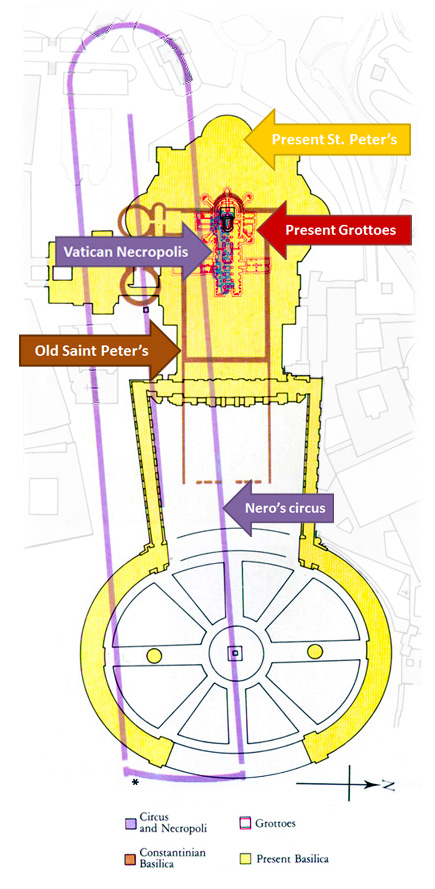
An interesting fact is that the Egyptian obelisk in the middle of St. Peter's square was originally in the center of the Circus. Peter was just put in the ground originally, but then a few years later they built a small monument around his grave. 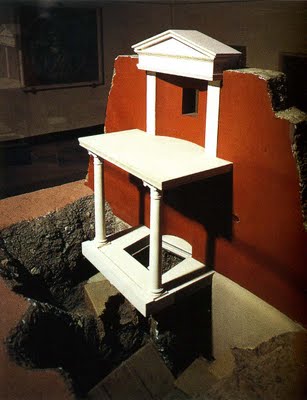
This is referred to as the "Gaius Trophy" because it was mentioned by a priest named Gaius in 120 AD. And I can show the trophies of the apostles. For if you choose to go to the Vatican or to the Ostian Road, you will find the trophies of those who founded this church. View Quote The Ostian Road seems to be referring to the relics of St. Paul, which now has St. Paul Outside the Walls built around it. Sadly, we arrived at St. Paul's just as they were locking up for the day and didn't get to see it. Eventually Old St. Peter's was built on top of the Gaius Trophy (which was encased in a large marble box). The popes began celebrating mass on that large marble box as well. The tour started down a road in the Necropolis. Roman families built their mausoleums in part for social status. 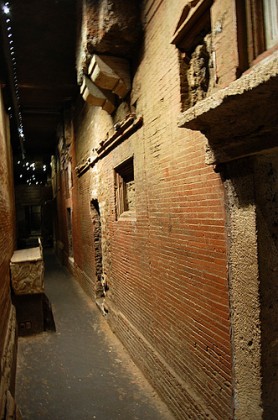
It's an underground city today. Pretty incredible. There were several mausoleums that were fully excavated. 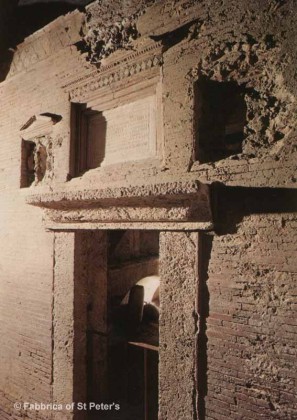
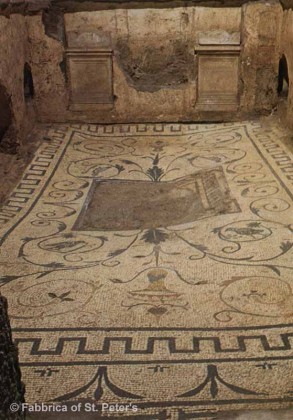
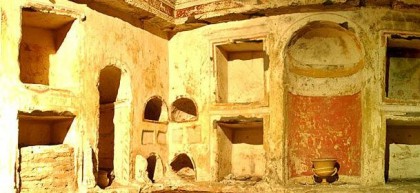
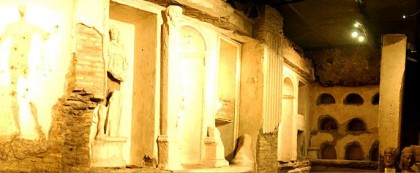
Eventually our tour, and the archeologists, reached a very special tomb. As we approached, you could see the red wall (see the picture of the Gaius Trophy above) 
A little further, you can see one of the columns from the Gaius Trophy! 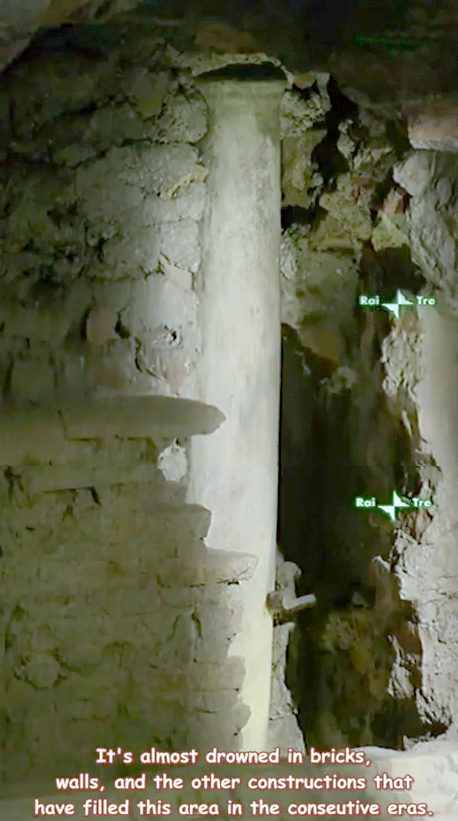
Finally, we arrived at the prize. The Tomb of St. Peter the Apostle. 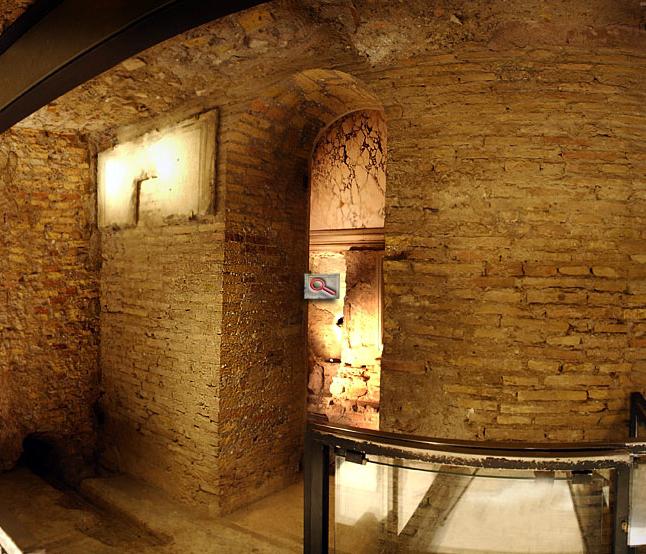

This wall with all the writing on it is called the "graffiti wall." There are many christian writings on there. 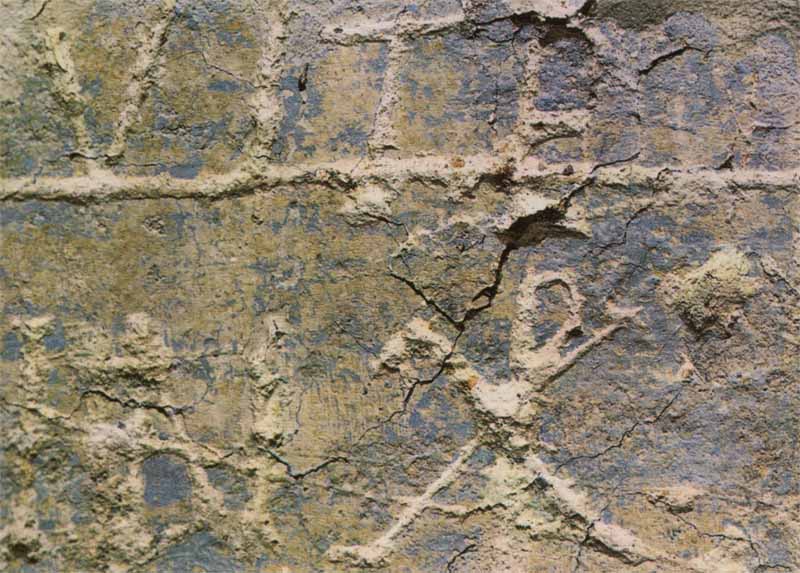
Note the Chi-Rho. The fragment was found nearby that said "Peter is Here." Inside the hole in the graffiti wall are the bone fragments in little plexiglass containers. They were found wrapped in a costly cloth. 
It really blew my mind to peek in that little hole and see the bones. On the other side of the tomb, a chapel was built. 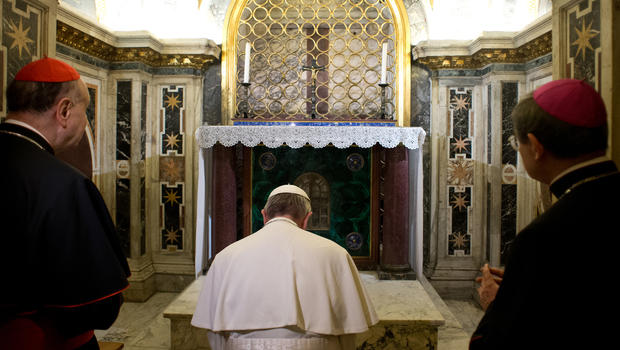

Here is a diagram to help show where everything is located: 
On the main floor, there is a lowered area in front of the main altar called the confessio. Underneath the main altar and behind the icon of Christ is the tomb. 
We exited into the Grotto where Popes and monarchs rest. Of note down there was JP1 and Bl. Paul VI. 
I didn't see any saints but there were sarcophagi of many popes that could be touched, so I whacked them with my rosary so that if they ever are declared saints, it would be a 3rd class relic. I whacked a lot of things with my rosary on this trip. 
Then, it was upstairs to the basilica... |
|
|
|
[#10]
Quoted:
Pics of wife's skirt?  - Just kidding. - Just kidding.
Awesome pictures. I lived about 90 minutes south of Rome for two years and made a handful of trips there, including multiple visits to St. Peters. Also fortunate enough to get a visit to Bethlehem and Jerusalem while I was overseas. Amazing places that really connect you to the past. View Quote View All Quotes View All Quotes Quoted:
Quoted:
My wife and I decided to climb the stairs. The monk in charge promptly kicked us out because my wife's dress was about an inch too short. Oh well, at least we made it up one step.  You could touch the actual stairs through holes in the wooden ones which was pretty cool. You could touch the actual stairs through holes in the wooden ones which was pretty cool.Pics of wife's skirt?  - Just kidding. - Just kidding.
Awesome pictures. I lived about 90 minutes south of Rome for two years and made a handful of trips there, including multiple visits to St. Peters. Also fortunate enough to get a visit to Bethlehem and Jerusalem while I was overseas. Amazing places that really connect you to the past. Her dress was modest by American standards.  She was mortified but I thought it was kind of funny. She was mortified but I thought it was kind of funny.
How did you like living in Italy? Were you in Naples? |
|
|
|
[#11]
Quoted:
Now I'm sorry we missed that. I knew the story, but didn't know about the church. View Quote View All Quotes View All Quotes Quoted:
Quoted:
Very beautiful. I hope to one day see these places. Did you stop by the Chapel Quo Vadis? History of Quo Vadis Along the Via Appia Antica, famous for its Christian catacombs, is the legendary site where the soon-to-be-Saint Peter, scurrying away from the Christian persecutions in Rome, met a vision of Christ blocking the road. The church built beside that site is called Domine, Quo Vadis—an odd name for a church, until you hear the parable behind it. The vision of Christ replied, "To Rome, to be crucified a second time," whereupon Jesus disappeared, leaving his footprints in the road's flagstone as a sign (there's a cast of them inside the church). A chastened Peter realized that Christ meant he was going to take the place of the weak-willed first pope and die, once again, for his faith. Peter turned around and returned to Rome to take his martyrdom like a man. (In fact, when it came to the moment, Peter gritted his teeth and told his executioners he was unworthy of being crucified in the same manner as his Lord and, in effect, asked them to "Do me upside down." This is why there are still a few St. Peter-related holy sites around Rome sporting upside-down crosses—so no, they're not for Satan-worshippers.) - See more at: http://www.reidsitaly.com/destinations/lazio/rome/sights/quo_vadis.html#.dpuf ETA : whenever I read about St Peter it makes me happy. He shows us that we are all so flawed & yet we can still be forgiven by God & risen so high by Him. It gives me so much hope. Now I'm sorry we missed that. I knew the story, but didn't know about the church. We missed it too. No idea it existed until now. |
|
|
|
[#12]
Quoted:
Her dress was modest by American standards.  She was mortified but I thought it was kind of funny. She was mortified but I thought it was kind of funny.
How did you like living in Italy? Were you in Naples? View Quote View All Quotes View All Quotes Quoted:
Quoted:
Quoted:
My wife and I decided to climb the stairs. The monk in charge promptly kicked us out because my wife's dress was about an inch too short. Oh well, at least we made it up one step.  You could touch the actual stairs through holes in the wooden ones which was pretty cool. You could touch the actual stairs through holes in the wooden ones which was pretty cool.Pics of wife's skirt?  - Just kidding. - Just kidding.
Awesome pictures. I lived about 90 minutes south of Rome for two years and made a handful of trips there, including multiple visits to St. Peters. Also fortunate enough to get a visit to Bethlehem and Jerusalem while I was overseas. Amazing places that really connect you to the past. Her dress was modest by American standards.  She was mortified but I thought it was kind of funny. She was mortified but I thought it was kind of funny.
How did you like living in Italy? Were you in Naples? Itri actually. Worked in Gaeta. I loved it. Almost no English speakers in my town. I lived inside the old city walls - it was amazing. |
|
|
|
[#14]
A couple of things you mentioned:
1. You saw the Grotto and the Scavi tour...did you climb to the top of the dome? Man...that was awesome. The height of that place is deceiving. Story has it that the carved text inside the basilica is carved at different heights to appear the same size throughout the building. For example, text that is 16 off the floor is carved some height 'x', text 20 feet up is 1.2x, and on and on. I don't know the real factors and sizes, but the fact that they made it happen in the 16th century is pretty impressive. 2. Did they still have JPII out on the basilica floor? He was there when, I believe next to the Pieta in November. John XXIII was on the floor as well as a couple of others - maybe Gregory and Pius, but the numbers elude me. 3. St. Paul's is neat and big and pretty, but to me it loses a little because it was built pretty recently as these things go. Fires happen and all, but that church was probably the least...moving(?)..to me. |
|
|
|
[#17]
|
|
|
|
[#19]
Milsurp, thanks again for posting your pictures and information. My wife and I are going to start planning a trip to Italy in the near future. I had a knee replaced in June and will possibly have the other one done too so I have to be healed and ready for a lot of walking before we actually set a date.
Did you just fly to Italy and tour on your own or did you go with a tour group? I am leaning toward a tour because I don't want to be showing up to see something and it is closed or unavailable. I would also consider going with a Church group or Church sponsored trip because it seems like those trips can get you into things that isn't generally available to the public. My mother went with a Church group and really had a great time. They held Mass just for their group in many interesting places. The trip was arranged by a priest who did these trips every other year, but now he is retired and not in good health. I don't know what the best tours are or if there are smaller private tours available. We are prepared to spend a good amount as this would be a very special trip. |
|
|
|
[#20]
Quoted:
Milsurp, thanks again for posting your pictures and information. My wife and I are going to start planning a trip to Italy in the near future. I had a knee replaced in June and will possibly have the other one done too so I have to be healed and ready for a lot of walking before we actually set a date. Did you just fly to Italy and tour on your own or did you go with a tour group? I am leaning toward a tour because I don't want to be showing up to see something and it is closed or unavailable. I would also consider going with a Church group or Church sponsored trip because it seems like those trips can get you into things that isn't generally available to the public. My mother went with a Church group and really had a great time. They held Mass just for their group in many interesting places. The trip was arranged by a priest who did these trips every other year, but now he is retired and not in good health. I don't know what the best tours are or if there are smaller private tours available. We are prepared to spend a good amount as this would be a very special trip. View Quote We just flew in to Italy and wandered around on our own.  It was fun, but I would probably try going with a pilgrimage group if there is a next time. The groups book tickets for a lot of things ahead of time so you can skip the line. We learned this the hard way when we got to the vatican museum an hour before they even opened and there was already an unbelievable line. It was fun, but I would probably try going with a pilgrimage group if there is a next time. The groups book tickets for a lot of things ahead of time so you can skip the line. We learned this the hard way when we got to the vatican museum an hour before they even opened and there was already an unbelievable line. I'll try to post more pics today. |
|
|
|
[#24]
Thanks for posting all these great pics Milsurp.
I had never heard of the veiled Christ or the statue of St. Peter in the net. They are magnificent!!! |
|
|
|
[#26]
Thank you so much for this thread. It amazes me that, even in light of these miracles / signs, people still don't believe in transubstantiation.
|
|
|
|
[#28]
Thanks for posting this stuff. I'm not a Catholic, but the churches and art within them from the Renaissance and earlier are fascinating to me. The obvious amount of work and care taken by the artisans is quite inspiring.
|
|
|
|
[#29]
Best thread ever! Excellent stuff. Stories from trips like this are a great way to pass on the Faith to the young ones. I'll get there one day.
Adoremus in Aeternum |
|
|
 Win a FREE Membership!
Win a FREE Membership!
Sign up for the ARFCOM weekly newsletter and be entered to win a free ARFCOM membership. One new winner* is announced every week!
You will receive an email every Friday morning featuring the latest chatter from the hottest topics, breaking news surrounding legislation, as well as exclusive deals only available to ARFCOM email subscribers.
AR15.COM is the world's largest firearm community and is a gathering place for firearm enthusiasts of all types.
From hunters and military members, to competition shooters and general firearm enthusiasts, we welcome anyone who values and respects the way of the firearm.
Subscribe to our monthly Newsletter to receive firearm news, product discounts from your favorite Industry Partners, and more.
Copyright © 1996-2024 AR15.COM LLC. All Rights Reserved.
Any use of this content without express written consent is prohibited.
AR15.Com reserves the right to overwrite or replace any affiliate, commercial, or monetizable links, posted by users, with our own.

